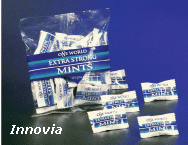To Serve & Protect
- Published: October 31, 2005, By Nsenga Byrd Thompson, Associate Editor
Product Focus
Don't fret over your next barrier coating purchase! Here’s some advice on how to choose and utilize these protective properties successfully.
Do Your Homework
- Determine what the final structure will be. What substrate(s) will be used? Will it be corona treated? Will it be primed? What is the primer?
- Identify desired barrier properties required from the structure: oxygen (low oxygen transmission rate); moisture (low water vapor transmission rate); odor, flavor, or grease.
- Agree upon how a product [for example, polyvinylidene chloride (PVDC)] will be used. If a PVDC is to be used as a barrier adhesive, what is the required bond strength? If a PVDC coating is to be used as a heat seal coating, what heat seal capabilities are required?
- Consider the drying capability of the coating or laminating line. PVDC latices are supplied at 45%–60% solids, so ovens must be capable of removing 40%–50% water. A web temperature of 185 deg F must be achievable for optimal barrier performance.
- Handle PVDC adhesives and coatings with care. These latices are corrosive because of their low pH (1.0–4.0). All parts in contact with PVDC latex should be either 316 stainless steel, plastic, continuous hard chrome with nickel flashing, or continuous ceramic.
- Don’t mix different PVDC latices together when they are wet. They may be incompatible, depending on how they’ve been stabilized.
- Maintain drying. Since maximum barrier is achieved when a continuous film is formed.
- Avoid high shear so you can achieve maximum stability.
- Use only recommended application techniques: reverse gravure, smooth roll Mayer rod, fountain-less gravure with smoothing rollers, or air knife.
- Water-cool the cylinders. Chilling the web between coating stations to the temperature of the PVDC latex and before rewind provides the best means to develop heat seal, slip, anti-block, gloss, and barrier properties. Chill roll temperatures should be set above the dew point to prevent moisture condensation onto the substrate.
- —John C. Norder Jr., business manager, packaging and converting, Rohm and Haas, rohmhaas.com
Pay Attention to Key Details
- Barrier properties of most materials are sensitive to relative humidity and temperature. Review the vendor’s data in order to judge the fitness for use.
- FDA regulations cover the use of a barrier material for retort or other high temperature use and storage conditions. It is necessary to verify compliance to suitable FDA regulations as well as verifying the technical requirements.
- Processing temperatures can degrade barrier properties of coatings and films. Test the final structures to verify maintenance of barrier.
- For metallized materials, scratching and crazing are common processing issues that reduce barriers of materials. Minimize barrier film damage in processing in order to maintain the manufacturer’s stated barriers.
- Besides O2 and H2O barrier, aroma and CO2 barrier, as well as UV light barrier, are important for many packaging structures.
- —Dr. Steven Sargent, director of research and development, Toray Plastics (America) Inc., torayfilms.com
Critical Factor
The most critical factor is what type of fluid or gas you want to stop from penetriating the substrate. The type of substrate also determines what barrier coatings you want. For example, if you’re looking to hold old nonpolar type materials, you generally want a substrate with high density. For aqueous materials, either a low- or high-density substrate will suffice. Another factor to consider is repulpability and/or recylability of the finished substrate. Generally, waxes and polyolefin films are not repulpable or recyclable, creating a cost for disposal.
Technical staff, Air Products, airproducts.com/barriers

For this and other barrier coating new products, see our November New Products page.
Restrictions of time and space limit the number of companies, products, and trends that we can discuss in these reports. For additional information, see PFFC’s features and departments each month, consult the June Buyers Guide, and search our online archives.





